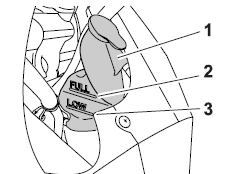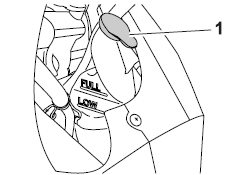Yamaha YZF-R125 Owners Manual: Coolant
The coolant level should be checked before each ride. In addition, the coolant must be changed at the intervals specified in the periodic maintenance and lubrication chart.
To check the coolant level
- Place the vehicle on a level surface and hold it in an upright position.
TIP
- The coolant level must be checked on a cold engine since the level varies with engine temperature.
- Make sure that the vehicle is positioned straight up when checking the coolant level. A slight tilt to the side can result in a false reading.
- Check the coolant level in the coolant reservoir.
TIP
The coolant should be between the
minimum and maximum level marks.

-
Coolant reservoir
-
Maximum level mark
-
Minimum level mark
- If the coolant is at or below the minimum level mark, remove the reservoir cap.

-
Coolant reservoir cap
- Add coolant to the maximum level
mark, and then install the reservoir
cap. WARNING! Remove only
the coolant reservoir cap. Never
attempt to remove the radiator
cap when the engine is hot.
NOTICE: If coolant is not available, use distilled water or soft tap water instead. Do not use hard water or salt water since it is harmful to the engine. If water has been used instead of coolant, replace it with coolant as soon as possible, otherwise the cooling system will not be protected against frost and corrosion. If water has been added to the coolant, have a Yamaha dealer check the antifreeze content of the coolant as soon as possible, otherwise the effectiveness of the coolant will be reduced.
| Coolant reservoir capacity (up to the maximum level mark): 0.25 L (0.26 US qt, 0.22 Imp.qt) |
Changing the coolant
The coolant must be changed at the intervals specified in the periodic maintenance and lubrication chart. Have a Yamaha dealer change the coolant.
 WARNING! Never attempt to remove
WARNING! Never attempt to remove
the radiator cap when the engine is
hot.
 Engine oil and oil filter element
Engine oil and oil filter element
The engine oil level should be checked
before each ride. In addition, the oil
must be changed and the oil filter element
replaced at the intervals specified
in the periodic maintenance and lub ...
 Replacing the air filter element and cleaning the check hose
Replacing the air filter element and cleaning the check hose
The air filter element should be replaced
at the intervals specified in the
periodic maintenance and lubrication
chart. Have a Yamaha dealer replace
the air filter element more frequently if
...
Other materials:
Checking the front fork
The condition and operation of the front
fork must be checked as follows at the
intervals specified in the periodic maintenance
and lubrication chart.
To check the condition
Check the inner tubes for scratches,
damage and excessive oil leakage.
To check the operation
Place the vehicle ...
Checking and lubricating the cables
The operation of all control cables and
the condition of the cables should be
checked before each ride, and the cables
and cable ends should be lubricated
if necessary. If a cable is damaged
or does not move smoothly, have a
Yamaha dealer check or replace it.
WARNING! Damage to the out ...
Checking the starter motor operation
1. Check:
Starter motor operation
Does not operate → Perform the electric
starting system troubleshooting, starting with
step 4.
Refer to "TROUBLESHOOTING" on page
8-9.
a. Connect the positive battery terminal "1" and
starter motor lead "2" with a jumper lead "3".
W ...
